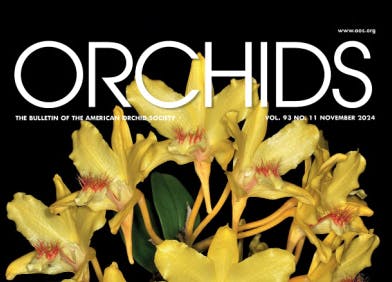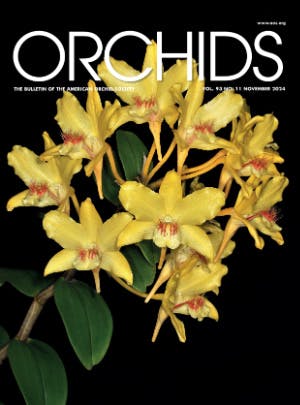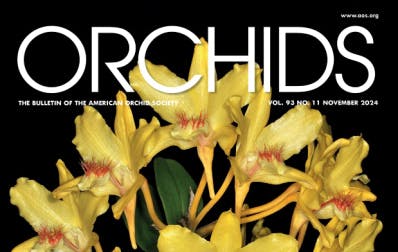
While popularly called scorpion orchids because of the upright dorsal sepals of many of the species resembling the stinger of a scorpion, they more correctly would be called spider orchids based on the scientific name Arachnis, from the Greek meaning “spider.” Their distinctive down-swept, falcate (sickleshaped) petals and lateral sepals also project a rather sinister appearance in these boldly colored flowers.
There are 14 accepted species, including the Esmeralda species (Plants of the World Online, 2024) in this monopodial genus (no pseudobulbs, only one main continuously growing stem). They are found throughout the warm, lower elevations of southeastern Asia from sea level to about 9,800 feet (3,000 m) ranging from southern China and Tibet to Indonesia, Malaysia and the Philippines. They are large to even giant-sized orchids with their stout branching stems reportedly scrambling 32 feet (10 m) or more, actually growing from tree to tree through the jungle, supported by thick roots that emerge along their length at leaf nodes. The many distichous leaves (alternating in two rows on the stem) are strap-shaped, thick and fleshy. These tough characteristics are undoubtedly a beneficial adaptation for them to survive in the tropical treetops, where they are regularly subjected to intense sun.
Blooming occurs from spring through early fall on branching inflorescences that emerge at the bases of the upper leaves. These inflorescences, initially erect and to 4 feet (1.2 m) long or more, eventually become quite pendulous from the weight of the 25 or more well-spaced flowers. With somewhat musty but not offensive fragrances, the long-lasting flowers (to two months or more) may be more than 4½ inches (11 cm) across. The most commonly grown and highly variable species, Arachnis flos-aeris (meaning “air flower”), epitomizes the typical colors on display throughout the species in this genus with a yellow base color highlighted with various degrees of bars and stripes from orange to red with some varieties even presenting a dark chocolate hue.
Because these plants can become quite large, many growers simply cut and repot the upper rooted portions or rooted branched sections when they begin to become too leggy. The lower remaining portions should not be discarded as they often produce several new growths, which may also be eventually removed for repotting once they develop roots.
[1] Arachnis flos-aeris photographed by the author.

[2] Arachnis clarkei ‘Wise’ CBM/AOS, grown by Ed Wise, was until recently one of the two species in a genus called Esmeralda. These have been moved to Arachnis based on genetic data.

LIGHT LEVELS
To produce an abundance of their attractive flowers, Arachnis prefer full sun — as many hours as you can provide — and are recorded blooming indoors as far north as Michigan.
TEMPERATURES
Arachnis, closely related to Vanda and Renanthera, prefer similar warm temperatures at night with minimums down to only 65 F (18 C). They may survive lower temperatures for short periods, but their ability to flower may be significantly diminished. Day temperatures may exceed 90 F (32 C) provided high humidity and good air circulation are provided.
POTTING AND WATERING
Whether grown in sphagnum moss in a hanging basket to accommodate their pendulous growth potentials or in a traditional pot of quick-draining bark mix, Arachnis need a regular watering and fertilizer regimen year round. It is most important the roots receive these regular drenchings but more important that the media does not become soggy or start to break down.
Whereas a potential challenge to control the size of this orchid, the longlasting and striking flowers are well worth the space they require.
[3] Arachnis plants are vinelike. Here plants have been trained on the fence surrounding the orchid garden at Gamboa Rainforest Resort in Panama.

[4] Arachnis plants, when given conditions they like, can become huge specimens.

[5] Arachnis cathcartii ‘Joyce’ AM/AOS grown by Jack Brechtelsbauer.

— Charles Wilson is an accredited AOS judge out of the Atlanta Judging Center who has been growing orchids for more than 45 years. His special interests include Bulbophyllum, Cattleya, Coelogyne, Galeandra, Paphiopedilum and everything else, too. He is an active volunteer with the AOS (email zooemeritus@gmail.com).











